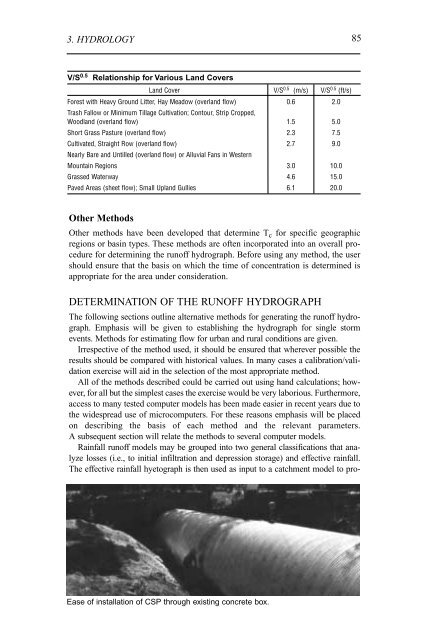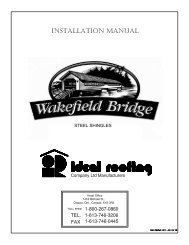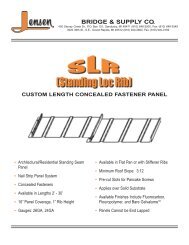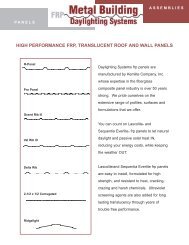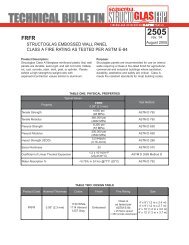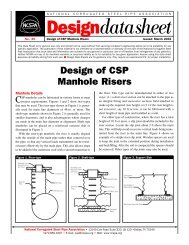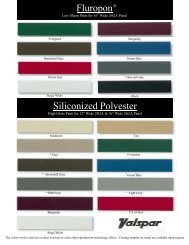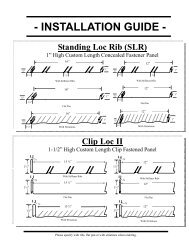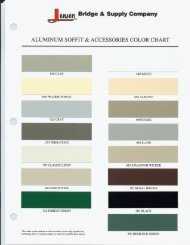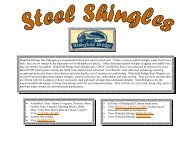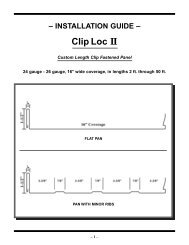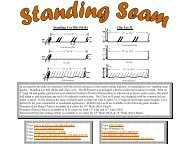- Page 1 and 2:
®ModernSewerDesignFirst Edition 19
- Page 3 and 4:
PrefaceiiiThis Edition of AISI’s
- Page 5 and 6:
The Kirpich Formula ...............
- Page 8 and 9:
viiiMODERN SEWER DESIGNFabricated f
- Page 10 and 11:
2 MODERN SEWER DESIGNRoundPipe Arch
- Page 12 and 13:
4 MODERN SEWER DESIGNTable 1.3M(Con
- Page 14 and 15:
6 MODERN SEWER DESIGNTable 1.3(Cont
- Page 16 and 17:
8 MODERN SEWER DESIGNTable 1.4M(Con
- Page 18 and 19:
10 MODERN SEWER DESIGNTable 1.4(Con
- Page 20 and 21:
12 MODERN SEWER DESIGNPerforated Pi
- Page 22 and 23:
14MODERN SEWER DESIGNTable 1.8Size
- Page 24 and 25:
16 MODERN SEWER DESIGNRt18”Rb18
- Page 26 and 27:
18 MODERN SEWER DESIGNRt31”Rb31
- Page 28 and 29:
20 MODERN SEWER DESIGNTable 1.11M(C
- Page 30 and 31:
22 MODERN SEWER DESIGNTable 1.11(Co
- Page 32 and 33:
24 MODERN SEWER DESIGNCSP COUPLING
- Page 34 and 35:
26 MODERN SEWER DESIGNFor unusual c
- Page 36 and 37:
28 MODERN SEWER DESIGNTable 1.13MMi
- Page 38 and 39:
30 MODERN SEWER DESIGNTable 1.14MMi
- Page 40 and 41:
32 MODERN SEWER DESIGNTable 1.15MMi
- Page 42 and 43: 34 MODERN SEWER DESIGNSaddle Branch
- Page 44 and 45: 36 MODERN SEWER DESIGNManholes and
- Page 46 and 47: 38 MODERN SEWER DESIGNManhole Reinf
- Page 48 and 49: 40 MODERN SEWER DESIGNManhole Steps
- Page 50 and 51: 42 MODERN SEWER DESIGNSpiral Rib St
- Page 52 and 53: 44 MODERN SEWER DESIGNTable 1.16Mat
- Page 54 and 55: 46 MODERN SEWER DESIGNCSP sewer des
- Page 56 and 57: 48MODERN SEWER DESIGNIt is not econ
- Page 58 and 59: 50MODERN SEWER DESIGNMETHODS TO RED
- Page 60 and 61: 52MODERN SEWER DESIGNTwin 180 m (59
- Page 62 and 63: 54MODERN SEWER DESIGNsive structura
- Page 64 and 65: 56MODERN SEWER DESIGNTable 2.2 Medi
- Page 66 and 67: 58MODERN SEWER DESIGNThe general re
- Page 68 and 69: 60MODERN SEWER DESIGNbe evaluated f
- Page 70 and 71: 62MODERN SEWER DESIGN7 m (24 ft) di
- Page 72 and 73: 64MODERN SEWER DESIGNPrecipitationR
- Page 74 and 75: 66MODERN SEWER DESIGNRainfall Inten
- Page 76 and 77: 68MODERN SEWER DESIGNestimates. It
- Page 78 and 79: 70MODERN SEWER DESIGNThe first quar
- Page 80 and 81: 72MODERN SEWER DESIGNSurfaceDepress
- Page 82 and 83: 74MODERN SEWER DESIGNTable 3.4 Reco
- Page 84 and 85: 76MODERN SEWER DESIGNTable 3.5 Runo
- Page 86 and 87: 78MODERN SEWER DESIGNThe selection
- Page 88 and 89: 80MODERN SEWER DESIGNDirect Runoff(
- Page 90 and 91: 82MODERN SEWER DESIGNThe Kirpich Fo
- Page 94 and 95: 86MODERN SEWER DESIGNduce a runoff
- Page 96 and 97: 88MODERN SEWER DESIGNDLq pt p t rFi
- Page 98 and 99: 90MODERN SEWER DESIGNHydrograph is
- Page 100 and 101: 92MODERN SEWER DESIGNIt is importan
- Page 102 and 103: 94MODERN SEWER DESIGNLaying full bi
- Page 104 and 105: 96MODERN SEWER DESIGNFabricated fit
- Page 106 and 107: 98 MODERN SEWER DESIGNCLASSIFICATIO
- Page 108 and 109: 100 MODERN SEWER DESIGNV 12/2gEGL 1
- Page 110 and 111: 102 MODERN SEWER DESIGNThe critical
- Page 112 and 113: 104 MODERN SEWER DESIGN700600Pipe-A
- Page 114 and 115: 106 MODERN SEWER DESIGN20001500Pipe
- Page 116 and 117: 108 MODERN SEWER DESIGNTable 4.1MWa
- Page 118 and 119: 110 MODERN SEWER DESIGNHydraulic Pr
- Page 120 and 121: 112 MODERN SEWER DESIGN(or velocity
- Page 122 and 123: 114 MODERN SEWER DESIGNTable 4.9 Va
- Page 124 and 125: 116 MODERN SEWER DESIGNSolving the
- Page 126 and 127: 118 MODERN SEWER DESIGNFULL908070We
- Page 128 and 129: 120 MODERN SEWER DESIGNSurface Wate
- Page 130 and 131: 122 MODERN SEWER DESIGNFORM LOSSES
- Page 132 and 133: 124 MODERN SEWER DESIGNTable 4.14Va
- Page 134 and 135: 126 MODERN SEWER DESIGN1.41.2rD1.0o
- Page 136 and 137: 128 MODERN SEWER DESIGNTable 4.15 E
- Page 138 and 139: 130 MODERN SEWER DESIGNT = 2.5 mINL
- Page 140 and 141: 132 MODERN SEWER DESIGN600 mm (24 i
- Page 142 and 143:
134 MODERN SEWER DESIGNFrom Table 4
- Page 144 and 145:
136 MODERN SEWER DESIGNDefinitionsS
- Page 146 and 147:
138 MODERN SEWER DESIGNREFERENCES1.
- Page 148 and 149:
140 MODERN SEWER DESIGNFabricated f
- Page 150 and 151:
142MODERN SEWER DESIGNBACKWATER ANA
- Page 152 and 153:
144MODERN SEWER DESIGNTable 5.1 Ene
- Page 154 and 155:
146MODERN SEWER DESIGNTable 5.2 Hyd
- Page 156 and 157:
148MODERN SEWER DESIGN30°31 2Q 1 =
- Page 158 and 159:
Flow Channel150MODERN SEWER DESIGN1
- Page 160 and 161:
152MODERN SEWER DESIGNMETHODS OF DE
- Page 162 and 163:
154MODERN SEWER DESIGNEXAMPLE:Given
- Page 164 and 165:
156MODERN SEWER DESIGNEXAMPLE:Given
- Page 166 and 167:
158MODERN SEWER DESIGNTable 5.3M Me
- Page 168 and 169:
160MODERN SEWER DESIGN43.5320 m rig
- Page 170 and 171:
162MODERN SEWER DESIGNTable 5.4Typi
- Page 172 and 173:
164MODERN SEWER DESIGNNSchoolGreenB
- Page 174 and 175:
166MODERN SEWER DESIGNlowing steps
- Page 176 and 177:
168MODERN SEWER DESIGNCulvert desig
- Page 178 and 179:
170MODERN SEWER DESIGNTable 5.6M Pr
- Page 180 and 181:
172MODERN SEWER DESIGNTable 5.7M Hy
- Page 182 and 183:
174MODERN SEWER DESIGNDetailed Metr
- Page 184 and 185:
176MODERN SEWER DESIGNTable 5.8 Equ
- Page 186 and 187:
178MODERN SEWER DESIGNTable 5.9 Maj
- Page 188 and 189:
180MODERN SEWER DESIGNTable 5.10M F
- Page 190 and 191:
182MODERN SEWER DESIGNTable 5.11Com
- Page 192 and 193:
184MODERN SEWER DESIGNTwo 6 m (20 f
- Page 194 and 195:
186MODERN SEWER DESIGNDownspoutsDis
- Page 196 and 197:
188MODERN SEWER DESIGNLarge 95,000
- Page 198 and 199:
190MODERN SEWER DESIGN0.1Step 1:cfs
- Page 200 and 201:
192MODERN SEWER DESIGN160014001200E
- Page 202 and 203:
194MODERN SEWER DESIGNOTHER DETENTI
- Page 204 and 205:
196MODERN SEWER DESIGNSUBSURFACE DI
- Page 206 and 207:
198MODERN SEWER DESIGNOrdinary Back
- Page 208 and 209:
200MODERN SEWER DESIGNSOIL INVESTIG
- Page 210 and 211:
202MODERN SEWER DESIGNArea (a)Posit
- Page 212 and 213:
204MODERN SEWER DESIGNPoint Source
- Page 214 and 215:
206MODERN SEWER DESIGN600 mm (24 in
- Page 216 and 217:
208MODERN SEWER DESIGN375 mm (15 in
- Page 218 and 219:
210MODERN SEWER DESIGNThe soil inve
- Page 220 and 221:
212MODERN SEWER DESIGNCONSTRUCTION
- Page 222 and 223:
214MODERN SEWER DESIGNAt manhole, j
- Page 224 and 225:
216MODERN SEWER DESIGNCSP sewers ar
- Page 226 and 227:
218 MODERN SEWER DESIGNTable 7.1Hig
- Page 228 and 229:
220 MODERN SEWER DESIGNThe ultimate
- Page 230 and 231:
222 MODERN SEWER DESIGNRecommended
- Page 232 and 233:
224 MODERN SEWER DESIGNP vP cR cR t
- Page 234 and 235:
226 MODERN SEWER DESIGNInstalling a
- Page 236 and 237:
228 MODERN SEWER DESIGNTable 7.8Tab
- Page 238 and 239:
230MODERN SEWER DESIGNTable 7.10MDe
- Page 240 and 241:
232 MODERN SEWER DESIGNTable 7.11De
- Page 242 and 243:
234 MODERN SEWER DESIGNTable 7.12 D
- Page 244 and 245:
236 MODERN SEWER DESIGNTable 7.13 D
- Page 246 and 247:
238 MODERN SEWER DESIGNTable 7.14 M
- Page 248 and 249:
240 MODERN SEWER DESIGNTable 7.15 M
- Page 250 and 251:
242 MODERN SEWER DESIGNAerial Sewer
- Page 252 and 253:
244 MODERN SEWER DESIGNTable 7.18Al
- Page 254 and 255:
246 MODERN SEWER DESIGN26.4.2 Joint
- Page 256 and 257:
248 MODERN SEWER DESIGND 85 soil si
- Page 258 and 259:
250 MODERN SEWER DESIGNInstalling s
- Page 260 and 261:
252 MODERN SEWER DESIGNTable 8.1 Ty
- Page 262 and 263:
254 MODERN SEWER DESIGNField Studie
- Page 264 and 265:
256 MODERN SEWER DESIGNone of the b
- Page 266 and 267:
258 MODERN SEWER DESIGNProvides Add
- Page 268 and 269:
260 MODERN SEWER DESIGNFigure 8.2 E
- Page 270 and 271:
262 MODERN SEWER DESIGNperforation
- Page 272 and 273:
264 MODERN SEWER DESIGNConcrete Inv
- Page 274 and 275:
266 MODERN SEWER DESIGNchart were c
- Page 276 and 277:
268 MODERN SEWER DESIGN31. Potter,
- Page 278 and 279:
270 MODERN SEWER DESIGNWell points
- Page 280 and 281:
272MODERN SEWER DESIGNIt is functio
- Page 282 and 283:
274MODERN SEWER DESIGNcan be expect
- Page 284 and 285:
276MODERN SEWER DESIGNCost Savings
- Page 286 and 287:
278MODERN SEWER DESIGNTrenches shou
- Page 288 and 289:
280MODERN SEWER DESIGNBorrowing Rat
- Page 290 and 291:
282MODERN SEWER DESIGNPresent Value
- Page 292 and 293:
284MODERN SEWER DESIGNUsing differe
- Page 294 and 295:
286MODERN SEWER DESIGNTrunk sewer m
- Page 296 and 297:
288MODERN SEWER DESIGNFigure 10.1 L
- Page 298 and 299:
290MODERN SEWER DESIGNThe three pha
- Page 300 and 301:
292MODERN SEWER DESIGNTrench excava
- Page 302 and 303:
294MODERN SEWER DESIGNinstallation
- Page 304 and 305:
296MODERN SEWER DESIGNFull bitumino
- Page 306 and 307:
298MODERN SEWER DESIGNA wide variet
- Page 308 and 309:
300MODERN SEWER DESIGNA stringline
- Page 310 and 311:
302MODERN SEWER DESIGNUnderground C
- Page 312 and 313:
304MODERN SEWER DESIGN(2) ASTM A807
- Page 314 and 315:
306MODERN SEWER DESIGNPhiladelphia
- Page 316 and 317:
308MODERN SEWER DESIGNLarge diamete
- Page 318 and 319:
310 MODERN SEWER DESIGNGrass surfac
- Page 320 and 321:
312 MODERN SEWER DESIGNIf aggregate
- Page 322 and 323:
314 MODERN SEWER DESIGN(to which th
- Page 324 and 325:
316 MODERN SEWER DESIGNREHABILITATI
- Page 326 and 327:
318 MODERN SEWER DESIGNRelining Mat
- Page 328 and 329:
320 MODERN SEWER DESIGNInversion Li
- Page 330 and 331:
322 MODERN SEWER DESIGN
- Page 332 and 333:
324MODERN SEWER DESIGNTable C3SI de
- Page 334 and 335:
326MODERN SEWER DESIGNTable C5Non-S
- Page 336 and 337:
328MODERN SEWER DESIGNTable C8Engin
- Page 338 and 339:
330MODERN SEWER DESIGNTable C9 Prop
- Page 340 and 341:
332GENERAL TABLESTable G2 Canandian
- Page 342 and 343:
334 MODERN SEWER DESIGNDisclaimer i
- Page 344 and 345:
336 MODERN SEWER DESIGNRound fittin
- Page 346 and 347:
338 MODERN SEWER DESIGNNotes


